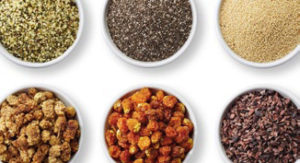
“Nature knows best.” That’s what many consumers believe, according to research firm Canadean. They found that eight in 10 consumers think that basic fruits and vegetables offer equal health benefits to packaged supplements. In simpler terms? Basic is better—making synthetic products that claim to boost health an especially hard sell.
In response, manufacturers and consumers alike are turning to superfoods. These are plants, nuts and seeds that contain high levels of vitamins, minerals, phytochemicals and other compounds with the potential to ward off diseases like certain cancers, high blood pressure, diabetes and arthritis. Per research firm Mintel, between 2011 and 2015, there was a 202 percent increase globally in the number of new food and drink products launched containing the terms “superfood,” “superfruit” or “supergrain.”
Still, superfoods aren’t an entirely new concept. Grocery store staples like bananas, kale, sweet potatoes, avocadoes and whole grains have long been known to pack a healthy punch of antioxidants, fiber and other beneficial nutrients. But as interest in superfoods has grown tremendously in recent years, so too has the buzz the surrounding lesser-known nutritional powerhouses like:
- cacao—seeds that contain flavonoids known to help lower blood pressure and improve blood flow to the brain and heart
- rooibos tea—a red tea chock-full of antioxidants believed to help prevent certain chronic or degenerative diseases
- spirulina—a dark blue-green, spiral-shaped algae that contains magnesium, calcium, vitamin K, potassium and a slew of other healthful minerals
- baobab—an African fruit that contains more vitamin C than oranges, more potassium than bananas and twice the calcium of milk.
A number of CPGs are now trialing new products that contain both established and emerging superfoods. For example, in 2016, Coca Cola launched Aquarius Vive in the Spanish market—a drink that includes zinc, vitamin B3 and baobab extract (whose inclusion is marketed front and center on the can’s packaging). Rhythm Superfoods has also helped create the “superfood” snack category and make kale a household name thanks to its widely popular kale chips, roasted kale and other plant-based snacks. In January 2017, Rhythm closed a $6 million financing round with 301 INC, the new business development and venture unit of General Mills.
With established superfoods like coconut, pomegranate, flaxseed and hemp dominating the largest market sizes in the U.S. right now, it’s going to be exciting to see what space consumer interest carves out for the newer superfoods in the years to come.
What makes superfoods so super?
In large part, it’s thanks to their healthy levels of:
- Antioxidants—These protect the body from wear and tear by stabilizing cell-damaging “free radicals” that form as we age. The more antioxidants present in the body, the less damage free radicals can cause.
- Nutrients—These are substances that are key to maintaining life and good health. Most superfoods contain essential vitamins and minerals, such as vitamin A, vitamin C, folate, magnesium and potassium. Some superfoods also deliver protein, healthy carbohydrates and healthy fats, such as omega-3s.
- Fiber—Known best for aiding digestion, fiber improves the absorption of certain nutrients and increases feelings of “fullness,” while decreasing the risk of certain diseases, such as heart disease, diabetes and colon cancer.

